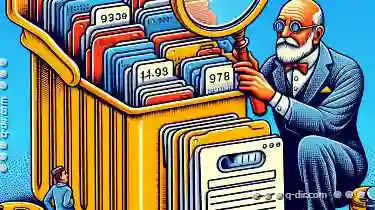From email spam to antivirus software, filters play a crucial role in managing and organizing vast amounts of information. However, few people are aware ...
 of the history behind this seemingly modern concept. Let's dive into the little-known history of file filtering, exploring how it evolved from simple manual practices to sophisticated automated systems. In the digital age, file filtering has become an essential aspect of data management.
of the history behind this seemingly modern concept. Let's dive into the little-known history of file filtering, exploring how it evolved from simple manual practices to sophisticated automated systems. In the digital age, file filtering has become an essential aspect of data management.1. The Early Days: Manual Filtering Methods
2. The Mid-20th Century: The Emergence of Computational Filters
3. The Digital Age: Machine Learning and Artificial Intelligence
4. Present and Future: Evolving Filtering Technologies
5. Conclusion
1.) The Early Days: Manual Filtering Methods
The origins of file filtering can be traced back to the 19th century when early computers were used for basic tasks like data processing and calculations. At this time, filtering was a largely manual process where human operators would manually review each piece of information to determine its relevance or spam status. This method was labor-intensive and error-prone but served as a precursor to more sophisticated automated filtering systems that we know today.
Key Innovations:
1. Human Censorship in the 20th Century: With the advent of mass communication, such as radio and television during the early 20th century, manual censorship became necessary to control the dissemination of information deemed inappropriate or harmful. This practice laid the groundwork for automated filtering systems by setting standards for what was considered acceptable content.
2.) The Mid-20th Century: The Emergence of Computational Filters
The mid-20th century saw significant advancements in computing power and digital storage, which enabled more sophisticated filtering methods. In the 1950s, some early forms of automated filtering began to appear, particularly in military applications where the automatic recognition of spam emails was crucial for national security.
Key Innovations:
2. Early Prototypes: The 1960s and 70s saw the development of more robust filtering systems, such as early email filters that could detect certain keywords or patterns indicative of spam. These initial efforts laid the foundation for what would eventually become machine learning-based algorithms used today.
3. Commercialization: Companies like IBM started incorporating filtering capabilities into their mainframe computers in the 1970s, gradually transitioning from manual to automated systems. This marked a significant shift towards more complex and efficient filtering solutions that could handle larger volumes of data.
3.) The Digital Age: Machine Learning and Artificial Intelligence
The digital age brought about exponential growth in data generation and an increased need for efficient handling of this information. In the late 20th century, machine learning algorithms began to replace rule-based systems, allowing filters to learn from patterns and improve their accuracy over time without explicit programming.
Key Innovations:
4. Machine Learning Algorithms: With advancements in AI and machine learning, filtering algorithms can now adapt and self-improve by analyzing vast amounts of data. This has led to significant improvements in spam detection rates and the ability to categorize emails or files based on content rather than simple rules.
5. Cloud Services: The rise of cloud computing made it possible for filters to operate at a larger scale, leveraging distributed processing power to handle even more extensive datasets efficiently.
4.) Present and Future: Evolving Filtering Technologies
Today, filtering technologies are integral components of various digital platforms and services, including email providers, antivirus software, and content management systems. The future looks promising with ongoing research into quantum computing and other advanced technologies that may further enhance the accuracy and speed of filtering processes.
Key Innovations:
6. Advancements in Quantum Computing: Some experts predict that quantum computing could revolutionize filtering by enabling faster processing and analysis of vast datasets, potentially leading to breakthroughs in detecting complex patterns and anomalies.
7. Regulation and Ethics: As data filtering becomes more pervasive, there is a growing need for ethical considerations and regulatory frameworks to protect user privacy and ensure fair use of personal information.
5.) Conclusion
The journey from manual censorship to sophisticated machine learning algorithms showcases the remarkable evolution of file filtering technologies over the years. From simple keyword filters to complex AI-driven solutions, the goal remains consistent: to efficiently manage and organize vast amounts of digital information in a way that is both effective and ethical. As we look towards the future, it's clear that filtering technology will continue to evolve, adapting to new challenges and leveraging cutting-edge science for even greater efficiency and accuracy.

The Autor: / 0 2025-04-12
Read also!
Page-
Icon View: Are We Too Complacent with Our Defaults?
One fundamental aspect that shapes these interfaces is the way we present information-and perhaps nowhere is this more evident than in iconography. ...read more
Keyboard Shortcuts for Navigating Icon View
Among the various ways to view files and folders, icon views offer a visual representation that helps users quickly assess the contents at a glance. ...read more
The Icon View Cult: Why Do We Blindly Adhere?
Among these, the icon view has carved out its niche, becoming an integral part of our daily interactions with computers, smartphones, and tablets. ...read more